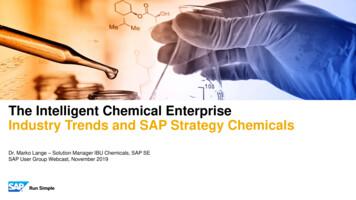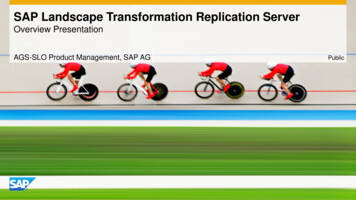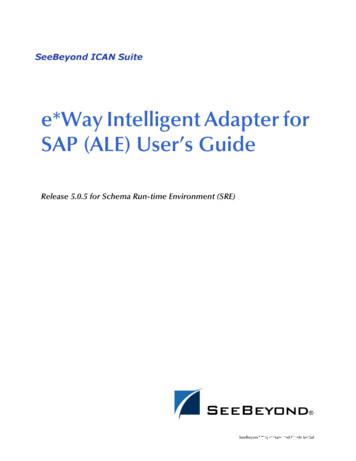Effective SAP SD - TechTarget
D. Rajen IyerEffective SAP SDGet the Most Out of Your SAP SD ImplementationBonn 폷 Boston
Contents at a Glance1Introduction and Overview .152Sales and Distribution Master Data andConfiguration: Applications and Processing .593Key Techniques in Sales and Distribution .914Influence of SD on Materials Management . 1275Supply Chain Extension of Sales andDistribution . 1656Financials and Controlling: Key Influenceand Interface . 1937Influence of SM and QM in SD Processes . 2238Reports, Analysis, User Interface andDevelopment Tools for SD . 2579Data Transfer, Outputs, Communication,and Interfaces with Other SAP Systems . 299AGlossary . 349BAbout the Author . 355Index . 357
Contents1Introduction and Overview . 151.11.21.31.41.51.61.72Sales and Distribution in the SAP World .1.1.1 Meeting Customer Requirements .1.1.2 Shipping Materials to the Customer .1.1.3 Getting Paid for Services or Goods .Key Influence of the Organizational Structure .1.2.1 Organizational Units .1.2.2 Linking Organizational Structures .Key Processes in Sales and Distribution .1.3.1 Sales Document Structure .1.3.2 Sources of Document Data .1.3.3 Controlling Business Processes in Sales .What is New in mySAP ERP? .1.4.1 Functionality Enhancements WithinSAP R/3 Releases .1.4.2 Sales Order Management .1.4.3 New Features in mySAP ERP 2005 .1.4.4 SAP Analytics .Summary .The Information Contained in This Book .How to Read This Book .17182020222333363839414547495152545457Sales and Distribution Master Data andConfiguration: Applications and Processing . 592.12.22.3Master Data in Sales and Distribution .2.1.1 Customer Master Data .2.1.2 Material Master Data .2.1.3 Condition Master Data .Sales and Distribution Processes:Data Determination and Processing .2.2.1 Plant .2.2.2 Shipping Point Determination .2.2.3 Route Determination .Controlling Sales Document withSales Document Type .2.3.1 Configuring Sales Document Types .606166707375757677797
Contents2.3.22.433.23.33.43.58589Pricing Fundamentals .3.1.1 Pricing Overview .3.1.2 Header Conditions .3.1.3 New Pricing .3.1.4 Pricing Configurations .3.1.5 Access Sequence .3.1.6 Condition Type .3.1.7 Procedure Determination .3.1.8 Working with Condition Records .3.1.9 Price Report .3.1.10 Special Functions .3.1.11 Special Condition Types .3.1.12 Determining Taxes, Rebates, andAgreements .Making Partner Determination Workfor Your Business .3.2.1 Partner Functions .3.2.2 Customer Master and Account Group .Working with Text Items .3.3.1 Text in Sales and Distribution Documents .3.3.2 Copying and Referencing Sales Texts .Copy Control and Requirements .3.4.1 Configuring Copy Control in SD .3.4.2 Data Transfer Routines and Requirements .Summary 121122124125Influence of SD on Materials Management . 1274.1882Key Techniques in Sales and Distribution . 913.14Controlling Sales Documentwith Item Category .2.3.3 Controlling Sales Documentswith Schedule Line Category .Summary .Availability .4.1.1 Availability Check Control .4.1.2 Back-Order Processing .4.1.3 Configuration Setting .4.1.4 MRP Types .4.1.5 Transfer Requirements .128130131132133135
Contents4.24.34.44.54.64.754.1.6 Batches .4.1.7 Bill of Material .Cross-Company Sales .4.2.1 Sales Order for Cross-Company Sales .4.2.2 Inter-Company Billing .Inter-Company and Cross-Company Stock Transfer .4.3.1 Stock Transport Orders .4.3.2 Materials Resource Planning .4.3.3 Document Type .4.3.4 Configurations Steps for Stock TransportOrder .4.3.5 Shipping Process .4.3.6 Goods Movement .Third-Party Processing .4.4.1 Ordering Through Third-Party Processing .4.4.2 Goods Receipt .4.4.3 Invoice Receipt .4.4.4 Customer Billing .Subcontracting .4.5.1 Procurement Process .4.5.2 Goods Movement .4.5.3 Sales and Distribution Delivery .4.5.4 Serial Numbers .Agreements .4.6.1 Scheduling Agreements .4.6.2 Contracts .4.6.3 Scheduling Agreements vs. Contracts .Summary 54155156157158160161161161162163Supply Chain Extension of Sales andDistribution . 1655.15.2Transportation with Logistics Execution andShipment Execution .5.1.1 Shipment Documents .5.1.2 Individual vs. Collective Shipments .5.1.3 Stages of Shipments .5.1.4 Delivery Split .5.1.5 Transportation .Warehouse Management Basics and BusinessProcess Outsourcing .1661671691711721731789
190Integration of Billing in SD Processes .6.1.1 Special Billing .6.1.2 Creating Billing Documents .6.1.3 Payment Processing .6.1.4 Reference Data for Account Posting .Account Determination .6.2.1 Ex Stock Sale Process .6.2.2 Sale of Services .6.2.3 Account Assignment Criteria .Financials Supply Chain Management .6.3.1 Financials Accounting .6.3.2 Electronic Bill Presentment and Payment .6.3.3 Credit and Risk Management .6.3.4 Settings .6.3.5 Value Contract .Interface with Profitability Analysis (CO-PA) .6.4.1 Evaluation and Reporting .6.4.2 Profitability Analysis Procedures .Summary 18219220Influence of SM and QM in SD Processes . 2237.110179180180Financials and Controlling: Key Influenceand Interface . 1936.17Basic Functions of WarehouseManagement .5.2.2 Interfaces with Other Applications .5.2.3 Organizational Structure .5.2.4 Delivery Processes with WarehouseManagement .Decentralized Warehouse Management .5.3.1 WMS Applications .5.3.2 Prerequisites for ConnectingDecentralized WMS to an ERP System .5.3.3 Inbound and Outbound Deliveries .5.3.4 Distributed Model .Summary .Service Management . 2247.1.1 Documents in Customer Services . 2267.1.2 Notification Types . 228
Contents7.27.37.47.57.687.1.3 Catalogs .7.1.4 Solution Database .Processing Service Orders .7.2.1 Order Components .7.2.2 Advance Shipment .7.2.3 Customer Consignment .7.2.4 Paging and Mobile .Complaints and Returns .7.3.1 Business Processes and Scenarios .7.3.2 Customizing Settings .Quality Processes in SD .7.4.1 Certification Planning .7.4.2 Certificate Processing .7.4.3 Batch Determination .7.4.4 QM in Delivery .Workflow .7.5.1 Workflow Architecture .7.5.2 Workflow Design .Summary 51253254Reports, Analysis, User Interface andDevelopment Tools for SD . 2578.18.28.38.4Quick Views, Query, Lists, and Reports .8.1.1 QuickViewer and Query .8.1.2 SAP Query .8.1.3 Lists and Report .Sales Information System .8.2.1 Analysis .8.2.2 Information Structures .SAP BW and Reporting Requirements .8.3.1 InfoObject .8.3.2 InfoCube .8.3.3 InfoProviders .8.3.4 Types of Data Stores .8.3.5 BW Architecture .8.3.6 Business Content .8.3.7 Sales Analytics .User Productivity .8.4.1 Internet Sales Representative Role .8.4.2 Enterprise Portal 8028511
Contents8.58.69287287289290297Data Transfer, Outputs, Communication,and Interfaces with Other SAP Systems . 2999.19.29.39.49.59.69.712Modifications and Enhancements—Conceptsand Application .8.5.1 Concepts .8.5.2 Personalization .8.5.3 Modifications and Enhancements .Summary .Data Transfer .9.1.1 Techniques in Detail .9.1.2 Data Transfer Workbench .9.1.3 Legacy System Migration Workbench .9.1.4 Direct Input .9.1.5 Intermediate Documents .9.1.6 Business Application ProgrammingInterfaces .Output Control .9.2.1 Output Determination: Applications .9.2.2 Output Determination: ConditionTechniques .Communication .9.3.1 Synchronous and Asynchronous RFCs .9.3.2 Configuration Set-Up .9.3.3 RFC Utilities .Interfaces with Other Systems .9.4.1 Basic Parts of the Business Framework .9.4.2 Function Builder .9.4.3 Business Application .Access Shared Data .9.5.1 ALE Applications .9.5.2 IDoc Applications .Interfacing with the GTS System .9.6.1 SAP Foreign Trade and GTS .9.6.2 Plug-In .9.6.3 Configuration .Sales Process with mySAP CRM .9.7.1 MySAP CRM Architecture .9.7.2 Internet Sales and Customer Self-Service .9.7.3 Interaction Center 16318319320324329330331333337339341342
Contents9.89.99.7.4 Integrating mySAP CRM with mySAP ERP .9.7.5 MySAP CRM Customization .Summary .Book Conclusion .342343344345Appendix . 347ABGlossary . 349About the Author . 355Acknowledgments . 355Index . 35713
This chapter will cover the key (or most popular) techniques used inSales and Distribution. You will become familiar with condition techniques as they are used in pricing. I will also go over some of thepowerful determination techniques with partner function and text.Last but not least, you will learn about data transfer to the subsequent document from the preceding document.3Key Techniques in Sales andDistributionSAP R/3, Enterprise version, and mySAP ERP use some common techniquesto apply your business rules to the processes you are designing in the system.Let’s say that in a sales transaction with a customer, you would like the finalprice to be based on the price of the material, any discount application,freight, and taxes. This determination depends on the business rules associated with that transaction.Similarly, you might like to have some kind of text determined, based on thedocument; e.g., a sales order has a purchase order text, and a delivery notehas the shipping instruction text. You would like some of the text items to becopied to subsequent documents; e.g., a special instruction for customerentered in the sales order copied to the delivery note.Creating a delivery document involves copying information from the salesorder, such as the materials and quantities. You can define control data forthe flow of documents. Configuration allows you to define the specificationsfor copy requirements and data transfer.Different customers can assume different roles in a business transaction. Thecustomer who places the order doesn’t necessarily have to be the same customer who receives the goods, or who is responsible for paying the invoice.Assigning partner roles in SAP Sales and Distribution (SD) determines thefunctions of particular partners in the sales process. We will examine the keyconfiguration techniques involved in setting up partner functions and determinations.91
3Key Techniques in Sales and Distribution3.1Pricing FundamentalsPricing procedure is associated with the sales document and provides the different components needed to come to final agreements with customers onthe price they will pay for the goods or service. Prices are stored as datawithin condition records. The values for condition could be for base price,surcharge, and discount. These are defined by condition types, which determine the category and describes how the condition is used.Condition ApplicationCondition Type Control DataPricePrice ListMaterial PriceCustomer rialK029Price GroupCustomer MaterialFixed amount based on time period.Calculation Type—Percentage,amount, or weightScale Bases—value or weightTable 3.1 Price Condition ApplicationTable 3.1 shows the condition for pricing and the different business application of this condition. These different business applications or categories ofconditions are identified by their condition types. The control data providesthe basis for calculation type and identifies any scale bases for value, weight,quantity, volume, or time period.Price conditions are maintained through transaction under the menu path:SAP Easy Access 폷 Logistics 폷 Sales and Distribution 폷 Master Data 폷 Conditions. Condition type configuration can
SAP R/3, Enterprise version, and mySAP ERP use some common techniques to apply your business rules to the processes you are designing in the system. Let’s say that in a sal
SAP ERP SAP HANA SAP CRM SAP HANA SAP BW SAP HANA SAP Runs SAP Internal HANA adoption roadmap SAP HANA as side-by-side scenario SAP BW powered by SAP HANA SAP Business Suite powered by SAP HANA Simple Finance 1.0 2011 2013 2014 2015 Simple Finance 2.0 S/4 HANA SAP ERP sFin Add-On 2.0
SAP Certification Material www.SAPmaterials4u.com SAP Certification Material for SAP Aspirants at Low cost Home Home SAP Business Objects SAP BPC CPM SAP BPC 7.0 SAP EWM SAP GTS SAP Public Sector SAP Real Estate SAP FSCM SAP FI/CO SAP AC - FI/CO SAP BI 7.0 SAP CRM 5.0
SAP Master Data Governance SAP Information Steward SAP HANA smart data integration SAP Data Hub SAP Cloud Platform Big Data Services SAP HANA, platform edition SAP Vora Customer Experience IoT Workforce Engagement SAP Cloud for Customer SAP Commerce SAP Marketing SAP Asset Intelligence Network SAP Predictive Maintenance and Service SAP .
SAP HANA Appliance SAP HANA DB In-Memory A io BI Client non-ABAP (SAP supported DBs) SAP Business Suite SAP Business Suite SAP Business Suite SAP Business Suite SAP Business Suite SAP Business Suite SAP Business Warehouse SAP HANA DB r In-Memory Source Systems SAP LT Replication Ser
ALE/RFC Setup 88 SAP System Type 88 SAP IDoc Version 88 Program ID (SAP to e*Gate) 88 SAP Load Balancing Usage (e*Gate to SAP) 89 SAP Application Server (e*Gate to SAP) 89 SAP Router String (e*Gate to SAP) 90 SAP System Number (e*Gate to SAP) 90 SAP Gateway Ho
Customer Roadmap to SAP Simple Finance - Example " Adopting SAP Simple Finance is a journey - start early" Side-by-side SAP HANA Acceleration SAP HANA accelerators, BW, BPC, GRC SAP Business Suite on SAP HANA SAP ERP on SAP HANA SAP ERP in SAP HANA Enterprise Cloud SAP Accounting Powered By SAP HANA Simple Finance add-on/
SAP Business Suite SAP BW SAP Apps Partner Apps SAP HANA PLATFORM Planning and Calculation Engine Real-Time Replication Services Information Composer & Modeling Studio SAP UI HTML5 Mobile SAP BI 4 SAP ERP SAP CRM SAP SCM SAP PLM SAP SRM SAP Netweaver Predictive Analytics & Business Function Libraries In-Memory
Sep 28, 2021 · SAP LLC “SAP Labs“ MEE Russian Federation SAP SAP CIS, LLC MEE Serbia SAP SAP West Balkans d.o.o. MEE Slovakia SAP SAP Slovensko s.r.o. MEE Slovakia SAP Ariba Ariba Slovak Republic, s.r.o. MEE Slovenia SAP SAP sistemi, aplikacije in produkti za obdelavo podatkov d.o.o. MEE Switzerland Emarsys Emarsys Schweiz GmbHFile Size: 598KB























